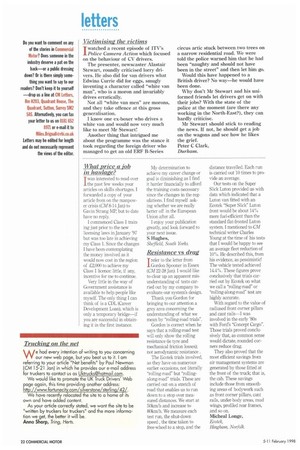Resistance vs drag
Page 24

If you've noticed an error in this article please click here to report it so we can fix it.
Irefer to the letter from Gordon Spooner in Essex (CM 22-28 Jan). [would like to clear up an apparent misunderstanding of tests carried out by my company to evaluate our system's design.
Thank you Gordon for bringing to our attention a grey area concerning the understanding of what we mean by "rolling-road trials".
Gordon is correct when he says that a rolling-road test will only show the rolling resistance (ie tyre and mechanical friction losses); not aerodynamic resistance.
The Ecotek trials involved, as they have on numerous earlier occasions, not literally "rolling-road" but "rollingalong-road" dials. These are carried out on a stretch of road that enables us to run down to a stop over measured distances. We start at 50km/h and increase to 80km1h. We measure each test run, the shut-down speed, the time taken to free-wheel to a stop, and the distance travelled. Each run is carried out 10 times to provide an average.
Our tests on the Super Slick Luton provided us with data which indicated that a Luton van fitted with an Ecotek "Super Slick" Luton front would be about 14% more fuel-efficient than the standard flat-fronted Luton system. I mentioned to CM technical writer Charles Young at the time of his tests that I would be happy to see an average fleet reduction of 10%. He described this, from his evidence, as pessimistic! The vehicle tested achieved 14.4%. These figures prove conclusively that trials carried out by Ecotek on what we call a "rolling-road" or "rolling-along-road" test are highly accurate.
With regard to the value of radiused front corner pillars and cant rails—I was involved in the early '80s with Ford's "Concept Cargo". Those trials proved conclusively that, as common sense would dictate, rounded corners reduce drag.
They also proved that the most efficient savings from air management systems are generated by those fitted at the front of the truck; that is, the cab. These savings include those from smoothing areas of bodywork such as front corner pillars, cant rails, under-body areas, mud wings, profiled rear frames, and so on.
Micheal Longe, Ecotek, Hingham, Norfolk.








































































































